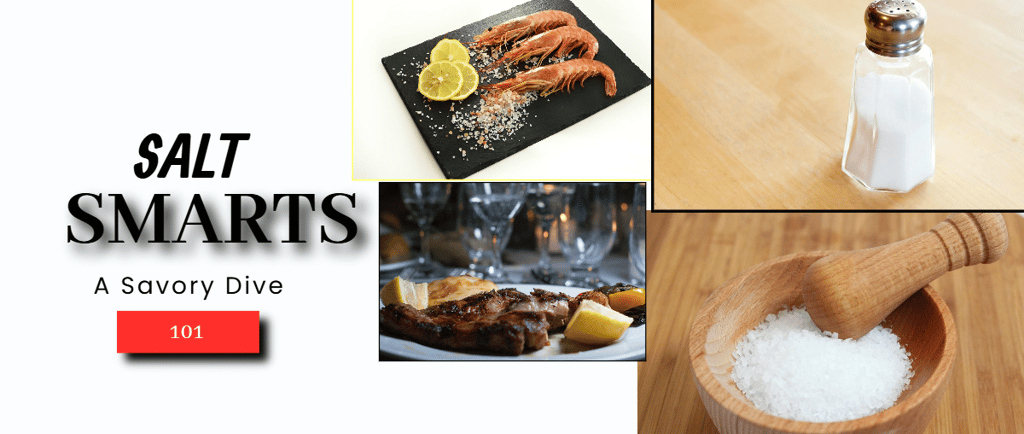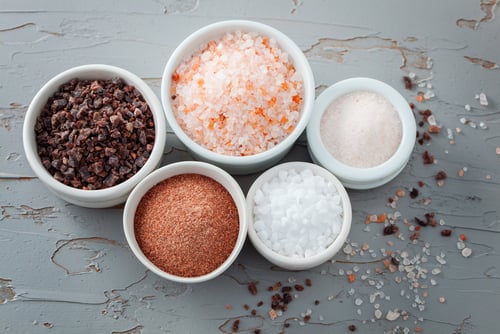Visit Innatefit1.com for exercise wear and equipment!!!
Salt Smarts 101: A Savory Dive into the Best Salt Types Comparison for Wellness Warriors
Discover the best salt types comparison in this comprehensive guide. Discover the differences between sea salt and table salt, the benefits of Himalayan pink salt, and the uses of black salts for wellness today!
SELF-HELPHEALTHY LIFESTYLEFITNESS TIPSRECIPES TO PLEASENUTRITION AND RECOVERYHEALTH
Joseph Battle
7/31/20258 min read


Introduction: The Flavor Revolution
Salt, the essence of flavor, has been an essential staple in kitchens and cuisines worldwide for centuries. However, with the rise of health consciousness and personalized nutrition, consumers are increasingly interested in understanding the various types of salt available.
This brings us to the “best types of salt comparison,” leading to a world of intrigue among wellness warriors, as different salts offer unique health benefits, flavor profiles, and culinary applications. From the familiar grains of table salt to exotic Himalayan pink salt, each type contributes its character to our diets.
As we journey through this in-depth analysis, we will uncover the nuances between sea salt and table salt, explore the health benefits of Himalayan pink salt, delve into the rich historical context and gut health benefits of black salt types, and consider how our cooking methods affect salt's performance and nutritional value.
By the end of this article, you'll be equipped to make informed choices about the salt you use in your cooking while aligning with your wellness goals. Let’s dive deeper into the salty ocean of knowledge!
The Best Salt Types Comparison for Everyday Health and Flavor
When it comes to enhancing flavors, not all salts are created equal. The best salt types comparison spans a wide variety, including kosher salt, sea salt, table salt, Himalayan pink salt, and various black salts, each with unique characteristics that can affect not only taste but also health.
Kosher Salt has gained popularity among chefs due to its coarse texture and ease of handling. This salt originates from the Jewish tradition of koshering meat, where it is used to draw out blood. While it’s often perceived as less salty because of its flaky structure, it’s an excellent choice for seasoning meat and vegetables during cooking. The texture allows for better adherence to food, offering a delightful crunch.
Sea Salt is harvested directly from the ocean, where seawater is evaporated to capture mineral-rich crystals. This salt retains trace minerals, contributing to a more complex flavor than regular table salt. The type of seawater, climate, and evaporation process can create unique flavors, making sea salt a flavorful option in cooking and finishing dishes.
On the other hand, Table Salt, the most common salt used today, is usually heavily processed and often contains additives like anti-caking agents. This processing strips it of minerals, resulting in a more concentrated sodium chloride level. While it serves as an effective seasoning in many households, the health implications of excessive table salt consumption are worth considering for wellness warriors.
Compared to Himalayan Pink Salt, with its distinctive pink hue, it is touted for its high mineral content and perceived health benefits. This salt is said to contain up to 80 trace minerals, including magnesium and potassium, making it an appealing choice for those seeking to enhance their nutritional intake while seasoning their meals.
Thus, when comparing the best salt types, one must weigh flavor preference against nutritional content, cooking methods, and overall wellness goals. Choosing the right salt can significantly impact your culinary experience and health, making it essential to explore the vast array of options available today.
Sea Salt vs Table Salt: Which One Truly Serves Your Body?
In the ongoing debate between sea salt and table salt, the distinctions extend beyond taste; they delve into the realm of nutritional value and health implications. As wellness warriors prioritize informed food choices, understanding these differences is paramount.
To start, Sea Salt is lauded for its natural origins. Typically harvested from oceans or saltwater lakes, sea salt undergoes minimal processing, which helps retain vital minerals. Unrefined sea salt can contain essential trace elements, such as calcium, potassium, and magnesium, which are beneficial in regulating various bodily functions.
These minerals contribute to maintaining proper fluid balance and muscle function, making sea salt a preferable option for health-conscious individuals.
In contrast, Table Salt is primarily refined and stripped of minerals, presenting a more concentrated form of sodium chloride. While it does provide the sodium necessary for various bodily functions, excessive consumption can lead to health risks like hypertension and cardiovascular concerns. For those monitoring their salt intake, understanding the sodium levels in table salt is crucial.
Another key aspect in the sea salt vs table salt debate is flavor. Sea salt's diverse textures and mineral content impart unique flavors to dishes, improving taste profile and depth. In culinary applications, this can significantly elevate a dish compared to the relatively one-dimensional flavor of table salt. The larger crystals of sea salt also provide a delightful crunch, serving as a finishing touch that enhances the overall dish presentation.
From a health perspective, both salts can be included in moderation; however, sea salt's mineral enhancements position it as a more advantageous option for individuals prioritizing everyday health. It’s beneficial to pay attention to the sourced varieties of sea salt, as mineral content can vary. Therefore, as a wellness warrior, choosing high-quality sea salt over processed table salt can enhance both the taste and health benefits of your meals.
Himalayan Pink Salt Benefits for Detox, Minerals, and Balance
When exploring various salt options, the benefits of Himalayan pink salt stand out remarkably, particularly in the realms of detoxification, mineral content, and balancing bodily functions. Harvested from ancient sea salt deposits in the Himalayan mountains, this salt is distinguished by its striking pink hues, which result from its rich mineral content, including iron, magnesium, and potassium.
For detoxification enthusiasts, Himalayan pink salt offers unique cleansing properties. When dissolved in water, it creates a solution known as a saline solution, believed to aid in flushing toxins from the body, enhance hydration, and boost energy levels. The minerals present in this salt can provide a natural balance, supporting cellular function and overall body health, thereby ensuring that our systems operate at their optimal level.
Moreover, the mineral content contributes to electrically charged ions, helping to regulate body PH levels and maintain an alkaline state. This balance is crucial for overall wellness, as it reduces the risk of chronic diseases. The minerals within Himalayan pink salt also support nerve function, muscle contractions, and hydration—crucial components for overall health and athletic performance.
In addition to its health benefits, Himalayan pink salt can be used in several culinary applications. It not only enhances flavor but can also be utilized creatively, such as in salt blocks for grilling or serving dishes, providing both aesthetic appeal and unique taste. Using Himalayan pink salt can easily align your cooking with your wellness goals, making it a worthy choice in the discussion about the best salt types.
However, as with any salt, moderation is key. While Himalayan pink salt offers several promising benefits, overconsumption can still lead to excessive sodium intake, emphasizing the importance of balanced meal planning.
Black Salt Types Comparison for Gut Health and Ancient Traditions
As we continue our exploration of salts, the spotlight shifts to black salt—an intriguing category comprising various types that hold deep historical roots and offer specific health benefits, particularly to gut health.
One prominent type is Himalayan Black Salt, known as kala namak. This salt is not only rich in minerals but also boasts a distinct flavor profile characterized by its umami taste and slightly smoky aroma. Used extensively in South Asian cuisine, it is prized not only for its culinary versatility but also for its purported health benefits.
It’s traditionally believed to support digestive health, alleviating issues such as heartburn and indigestion. The therapeutic properties attributed to Himalayan black salt stem from its mineral content, including potassium, which can promote proper digestion and balance stomach acidity.
In a comparison of black salt types, we also find Black Hawaiian Salt, known for its unique color due to the addition of activated charcoal, which offers additional detox benefits. It is often used in cleaning processes and has gained popularity for its ability to bind to toxins and support gastrointestinal health. This attribute makes it an appealing choice for wellness warriors focusing on gut health and detoxification.
Moreover, ancient traditions have incorporated black salt into their medicinal practices, underscoring its foundational role in promoting bodily balance. In Ayurveda, for instance, black salt is often recommended for its cooling properties, which are believed to reduce body heat. These historical contexts enrich its understanding and appreciation, bridging the gap between culinary uses and holistic health practices.
Thus, incorporating different types of black salt can provide not only an exciting flavor dimension to your dishes but also enhance overall digestive health. By embracing the diversity of black salt types, wellness enthusiasts can explore a range of flavors while prioritizing their bodily health, making it a worthwhile consideration in the broader conversation surrounding salt.
How Cooking Methods Affect Salt Performance and Nutrition
Beyond the type of salt used, the cooking methods applied can significantly influence the performance and nutritional value of salt in meals. Understanding these dynamics enables individuals to maximize their health benefits while enjoying flavorful cuisine.
Firstly, Boiling is one of the most common cooking methods where salt is directly integrated into the water. Adding salt during boiling enhances flavor absorption for pasta, vegetables, and grains.
However, it is crucial to find the right balance, as over-salting can inadvertently lead to higher sodium levels. Using high-quality sea salt in boiling can improve taste without significant health drawbacks, provided moderation is practiced.
In contrast, Grilling or Roasting offers another dynamic approach where salt acts not only as a seasoning but also contributes to texture. When sprinkled on meats or vegetables before grilling, salt helps draw moisture to the surface, creating a more pronounced flavor and a rewarding crust. Sea salt’s larger crystals can enhance this effect, providing a crunchy texture that elevates the overall dining experience.
Additionally, different salts exhibit varying performance under heat. For instance, while Himalayan salt can withstand high temperatures, it can also retain moisture better than regular table salt. The cooking method is crucial in determining the final flavor profile and texture of the dish, making salt an active participant in the culinary process rather than a passive ingredient.
Furthermore, the nutritional impact of salt can also be mitigated through the use of specific cooking techniques. For example, steaming vegetables retains more vitamin content than boiling, making it a healthier option when seasoning with salt. This knowledge empowers home cooks to make choices aligned with their wellness pursuits while maintaining the integrity of flavors and nutrients in their meals.
Choosing the Right Salt for Your Wellness Goals
Navigating the spectrum of salts available may seem daunting, but with a clear understanding of the health implications, flavor profiles, and culinary applications, selecting the right salt for your wellness goals becomes an engaging journey rather than a chore.
To begin, consider your primary wellness objectives. If you are focusing on mineral intake, Himalayan pink salt is an excellent option due to its impressive nutrient profile. Incorporating it into your daily cooking not only enhances flavor but also provides beneficial trace minerals.
Conversely, if you seek to improve digestion and gut health, experimenting with various types of black salt, such as kala namak or Black Hawaiian salt, can be advantageous. Their unique properties blend tradition and functionality, enriching your meals while addressing specific health concerns.
Additionally, the versatile sea salt encompasses a wide array of options, positioning it as an ideal go-to for everyday cooking. Its balance of minerals and flavor complexity makes it suitable for all culinary purposes while aligning with general wellness goals.
Finally, always be mindful of your sodium intake concerning your health circumstances. Regularly consuming processed foods can inadvertently escalate sodium levels; therefore, incorporating natural salts can help balance your overall sodium consumption. With this in mind, remember to use high-quality salts in moderation, harmonizing health and flavor for wholesome meals.
Conclusion: Embrace Your Salt Story
As we conclude this savory exploration of salts, it becomes clear that choosing the right salt involves more than just a desire for flavor. From a health perspective to culinary creativity and cultural traditions, salt plays a multifaceted role in our lives.
Understanding the differences in the best types of salt comparisons allows you, as a wellness warrior, to make informed choices that align with your dietary goals.
Whether you gravitate toward the mineral-rich Himalayas, classic sea salts, or eclectic black salts, incorporating these various types into your cooking can enhance both flavor and health benefits. As you embark on your culinary adventures, remember that every granule of salt carries a story of tradition, health, and flavor waiting to be experienced. So, let the exploration begin and relish the benefits of incorporating salt smarts into your kitchen.






